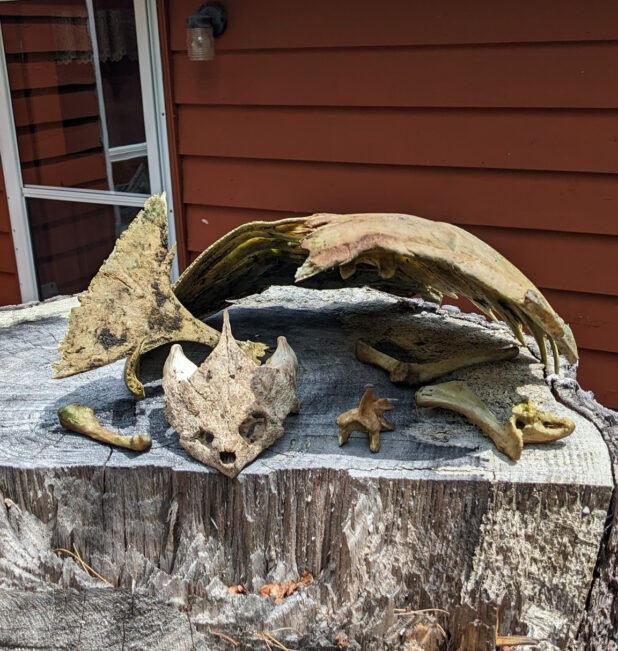Letters
In memory of Grace
August 1, 2023

To the Editor,
Haliburton Village in the Municipality of Dysart et al has been home to an unshakable mystery for over a year. What happened to the beloved one-eyed Snapping Turtle, affectionately known as “Grace?” She had inhabited the community for over 125 years until last year when she mysteriously disappeared. The absence of a celebrated community member that has generated excitement and news of sightings by Haliburton’s year-round and seasonal residents for years has not gone unnoticed and raised many questions. There have been theories and speculation but no answers until last week on July 28, when the Turtle Guardians shared the sad news that the remains of Grace were discovered surprisingly 15 kilometres from her home and in an entirely different watershed. Grace had distinct features that made identifying her skeletal remains by experienced individuals possible.
How did she end up so far from home? Snapping Turtles typically occupy home ranges of 0 to 3.9 kilometres, most average just 1.1 kilometres. They are adapted for aquatic life and rarely leave the water except during the breeding season or when moving to seasonal habitats within their home range. Leora Berman, COO of The Land Between, and esteemed members of the turtle conservation community agree that the chances of a seasoned Snapping Turtle being found such a distance from their home range doesn’t happen unless a turtle has been relocated that distance. The migration corridors Grace routinely traveled between winter and summer habitats each turtle season were widely known to the Turtle Guardians and Haliburton residents. Grace sightings were often shared. Turtles are creatures of habit and generally do not deviate from the route they travel each year.
The loss of any turtle or animal is unfortunate and cause for sorrow. The demise of a turtle that somehow evaded road mortality, habitat loss, the legal hunting of Snapping Turtles before 2017, pollution, and a long list of challenges turtles face negotiating today’s world for 125-plus years is a devastating loss.
Grace made her way into the headlines across the province last year in January 2022 after her brumation (hibernation) site, an Environmentally Protected wetland, was filled in. This land conversion went ahead due to the Municipality of Dysart et al not having a bylaw to prohibit the alteration of sensitive natural areas, as is common practice in municipalities across Ontario. After 1.5 years and 125,000 signatures on a petition the Turtle Guardians set up requesting the Council instate a bylaw acknowledging the natural heritage value of land and water that serves as existing habitat, the Municipality of Dysart et al have failed to install a standard site alteration bylaw to protect vulnerable wildlife habitats and species such as Grace.
We are not living in the 1970s when far less was understood publicly about protecting wildlife, natural habitat, and relocating wildlife. Information is available and shared publicly through education initiatives to increase awareness and bridge the gap between not knowing and knowing. The person or persons that relocated Grace likely did not realize that this action could prove fatal to this Snapping Turtle and that removing a turtle from their home range is illegal. There are lessons to be learned here, and they come at a steep price.
The first lesson is “PLEASE DO NOT” relocate turtles! They are species that are particularly sensitive to environmental changes. Where a turtle is located has a role in supporting its life cycle and the history that goes along with that. Most often, it is where the turtle was born. Turtles have several different habitats within their home range. This includes; (1) overwintering habitat (which can be very specific), (2) nesting habitat, and (3) active season habitat (feeding and breeding). Moving a turtle to a location that is “your” version of suitable habitat can have a monumental impact on a turtle and affect the resident turtle population.
When turtles are removed from their home range and relocated to suit the needs of human activities, they can suffer in many ways. Some of these include: the stress of being in unfamiliar territory may cause a turtle to be unable to find suitable food, shelter, or mates. Turtles who are unable to find their way home often die of starvation. Moving wildlife between populations can disrupt the local gene pool and reduce genetic diversity, potentially impacting the species’ long-term survival. Introducing new species or populations to an area can disrupt ecological balances and interactions, potentially harming native species and habitats. Due to these risks and complexities, relocating turtles or other wildlife species should not be considered or engaged in.
The second lesson is to co-exist with wildlife and not destroy natural habitats. Wildlife (animals, plants & microorganisms) and the ecosystems they support have a role in our basic needs; clean air to breathe, clean water to drink, food, materials for dwellings, and medicine. Life as we know it would not be possible without these services and goods provided. It is important to honor, respect, and protect that which makes life possible.
When considering land development, there are bylaws prohibiting or regulating site alterations. Please look to building on property already designated for development. Beautification projects that could destroy natural habitats lose something in translation. Building and upgrades, if absolutely necessary, should be approached with strategies that preserve existing natural habitat, create corridors, and, where appropriate, restore and maintain and enhance sensitive natural areas to protect and preserve wildlife and their home ranges. Land left natural is more beneficial to humans.
What happened to Grace is tragic and reminds us as humans that we significantly impact the lives of wildlife and habitat. Whether we act as responsible stewards of the environment and its wildlife, how we handle this responsibility reflects our moral principles beyond just other humans. Protecting wildlife and natural habitat protects us all!
Please sign the “In The Name Of Grace” petition at: (https://www.change.org/inthenameofgrace) to encourage the Municipality of Dysart et al to implement a standard site alteration bylaw to protect important wildlife habitats and species in their community.
Thank you to the Turtle Guardians Team for their ongoing efforts protecting wildlife and habitat and for seeing that Grace got back home. R.I.P. Grace.
Kelly Wallace, Think Turtle Conservation Initiative
L’Amable, Ontario


















